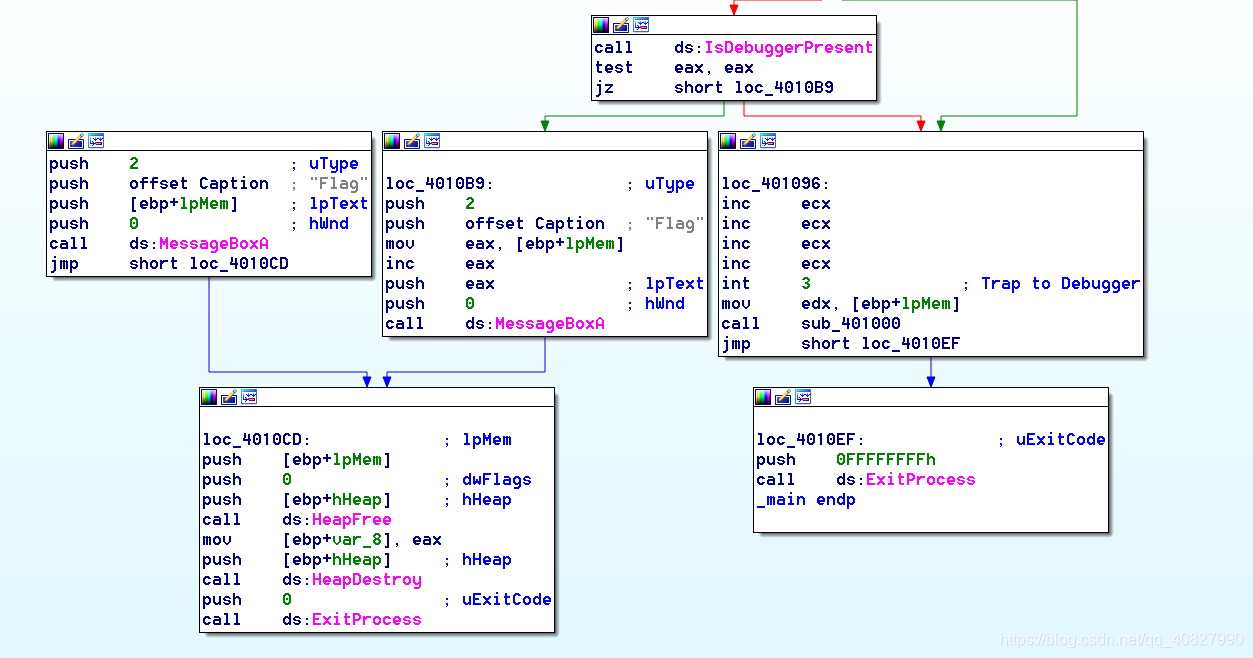Warmup
很简单,就是字符串的异或操作:
s = [0x4C, 0x44, 0x59, 0x56, 0x4C, 0x51, 0x4D, 0x5A, 0x48, 0x75,
0x59, 0x3A, 0x7C, 0x63, 0x51, 0x5B, 0x5E, 0x51, 0x79, 0x6F,
0x7C, 0x63, 0x51, 0x7B, 0x7E, 0x51, 0x59, 0x4F, 0x5C, 0x43,
0x51, 0x5B, 0x5E, 0x2F, 0x73]
flag = ''
for i in range(0,len(s)):
flag = flag + chr(s[i] ^ 0xE)
print("flag: " + flag)
app-release
字符串的异或操作:
key = 'PXEJPMQFTiS|v`"#vMDw`KMA3_b~w3o'
lenth = len(key)
print(lenth)
flag = ""
for i in range(0,lenth):
flag = flag + chr(ord(key[i])^18)
print("flag: " + flag)
逆向练习
程序比较简单,取特定字符串中的不同位置的字符连接成flag,然后再末尾加上1024}:
#include<stdio.h>
#include<string.h>
int main()
{
int esi,bl,ebx,i;
char flag[0x12];
char str[] = "sKfxEeft}f{gyrYgthtyhifsjei53UUrrr_t2cdsef66246087138\0087138";
int num[] = {0x1,0x4,0xe,0xa,0x5,0x24,0x17,0x2a,0xd,0x13,0x1c,0xd,
0x1b,0x27,0x30,0x29,0x2a};
for(i=0;i<0x11;i++)
{
flag[i] = str[num[i]];
}
printf("flag: %s",flag);
// KEY{e2s6ry3r5s8f610241024}
return 0;
}
rev2

主要函数在sub_401000处,这个函数在正常情况下是调用不到的,因为它上面有一个int 3断点,可以通过修改eip或将int 3指令nop掉:

然后就可以进入主要函数了,flag就会自己被异或出来:

crackme(ais3)
ida F5查看:
int __cdecl main(int argc, const char **argv, const char **envp)
{
int result; // eax@2
if ( argc == 2 )
{
if ( verify(argv[1]) )
puts("Correct! that is the secret key!");
else
puts("I'm sorry, that's the wrong secret key!");
result = 0;
}
else
{
puts("You need to enter the secret key!");
result = -1;
}
return result;
}
关键函数verify():
__int64 __fastcall verify(__int64 key)
{
int i; // [sp+14h] [bp-4h]@1
for ( i = 0; *(i + key); ++i )
{
if ( encrypted[i] != (((*(i + key) ^ i) << ((i ^ 9) & 3)) | ((*(i + key) ^ i) >> (8 - ((i ^ 9) & 3)))) + 8 )
return 0LL;
}
return i == 23;
}
就是将我们输入的字符串进行一些简单的计算,然后与encrypted数组比较;
注意最后比较的是al的值,所有要除以(16*16)取余:
movzx eax, encrypted[rax]
cmp al, [rbp+var_5]
jz short loc_40059D
#include<stdio.h>
#include<string.h>
int main()
{
int esi,bl,ebx,i;
int encrypted[24] = {0xca,0x70,0x93,0xc8,0x6,
0x54,0xd2,0xd5,0xda,0x6a,0xd1,0x59,0xde,0x45,
0xf9,0xb5,0xa6,0x87,0x19,0xa5,0x56,0x6e,0x63};
char flag[24];
for(i=0;i<23;i++)
{
ebx = 0;
while(1)
{
bl = ((((ebx ^ i) << ((i ^ 9) & 3)) | ((ebx ^ i) >> (8 - ((i ^ 9) & 3)))) + 8)%(16*16);
if(encrypted[i]==bl)
{
flag[i] = ebx;
printf("ebx: 0x%x\n",ebx);
break;
}
ebx ++;
}
}
printf("flag: %s",flag);
return 0;
}
这道题还一个用angr工具来做,参考:
https://blog.csdn.net/doudoudouzoule/article/details/79871979
https://www.freebuf.com/sectool/143056.html
trace(0CTF)
angr的提升用法,网上找了一个脚本:
from __future__ import print_function
import struct
import angr
MAIN_START = 0x4009d4
MAIN_END = 0x00400c18
FLAG_LOCATION = 0x400D80
FLAG_PTR_LOCATION = 0x410EA0
def load_trace():
res = []
delay_slots = set()
with open("./trace_8339a701aae26588966ad9efa0815a0a.log") as f:
for line in f:
if line.startswith('[INFO]'):
addr = int(line[6:6+8], 16)
res.append(addr)
# every command like this is in delay slot
# (in this particular binary)
if ("move r1, r1" in line):
delay_slots.add(addr)
return res, delay_slots
def main():
trace_log, delay_slots = load_trace()
# data.bin is simply the binary assembled from trace,
# starting on 0x400770
project = angr.Project("./data.bin", load_options={
'main_opts': {
'backend': 'blob',
'custom_base_addr': 0x400770,
'custom_arch': 'mipsel',
},
})
state = project.factory.blank_state(addr=MAIN_START)
state.memory.store(FLAG_LOCATION, state.solver.BVS("flag", 8*32))
state.memory.store(FLAG_PTR_LOCATION, struct.pack("<I", FLAG_LOCATION))
#sm = project.factory.simulation_manager(state) #why? not use it
choices = [state]
print("Tracing...")
for i, addr in enumerate(trace_log):
if addr in delay_slots:
continue
for s in choices: #find the state of this address in the choices
if s.addr == addr:
break
else:
raise ValueError("couldn't advance to %08x, line %d" % (addr, i+1))
if s.addr == MAIN_END:
break
# if command is a jump, it's followed by a delay slot
# we need to advance by two instructions
# https://github.com/angr/angr/issues/71
if s.addr + 4 in delay_slots:
choices = project.factory.successors(s, num_inst=2).successors
else:
choices = project.factory.successors(s, num_inst=1).successors
state = s
print("Running solver...")
solution = state.solver.eval(state.memory.load(FLAG_LOCATION, 32), cast_to=str).rstrip(b'\0').decode('ascii')
print("The flag is", solution)
return solution
def test():
assert main() == "0ctf{tr135m1k5l96551s9l5r}"
if __name__ == "__main__":
main()
momo(0CTF)
还是angr:
import sys
import string
import angr
from angr.block import CapstoneInsn, CapstoneBlock
ins_char = 0x81fe6e0
flag_char = 0x81fe6e4
after_fgets = 0x08049653
mov_congrats = 0x0805356E
def main():
p = angr.Project('./momo', load_options={'auto_load_libs': False}) #load the binary files
addr = after_fgets
size = mov_congrats - after_fgets
# let's disasm with capstone to search targets
insn_bytes = ''.join(
p.loader.memory.read_bytes(addr, size))
insns = []
for cs_insn in p.arch.capstone.disasm(insn_bytes, addr):
insns.append(CapstoneInsn(cs_insn))
block = CapstoneBlock(addr, insns, 0, p.arch)
targets = []
# let's keep track of the state
state = 0
for ins in block.insns:
if state == 0:
if ins.op_str == 'edx, dword ptr [edx*4 + 0x81fe260]':
state += 1
continue
if state == 1:
if ins.op_str == 'al, byte ptr [0x81fe6e0]':
state += 1
continue
if state == 2:
if ins.op_str == 'dl, byte ptr [0x81fe6e4]':
targets.append(ins.address + ins.size) #targets are addrs
state = 0
print "found {:d} targets".format(len(targets))
assert len(targets) == 28
flag_arr = ['0', 'c', 't', 'f', '{']
for target in targets[5:]:
print "\nexamining target {:#x}:".format(target)
for trychar in string.printable:
print trychar,
sys.stdout.flush()
flag = ''.join(flag_arr)+trychar
state = p.factory.entry_state()
state.posix.files[0].content.store(0, flag + "\n") #have no idea about posix.files
e = p.surveyors.Explorer(start=state, find=(target,))#find target states from entry state
e.run()
assert len(e.found) == 1
np = e.found[0] #find the first state with target
while(True):
nb_size = target - np.addr
if nb_size <= 0:
break
np = p.factory.successors(np, size=nb_size).flat_successors[0]
assert nb_size == 0
al = np.regs.eax[7:0]
dl = np.regs.edx[7:0]
al_val = al._model_concrete.value
dl_val = dl._model_concrete.value
if al_val == dl_val:
flag_arr.append(trychar)
break
return ''.join(flag_arr)
def test():
assert main() == '0ctf{m0V_I5_tUr1N9_c0P1Et3!}'
if __name__ == '__main__':
print main()





















 760
760











 被折叠的 条评论
为什么被折叠?
被折叠的 条评论
为什么被折叠?








